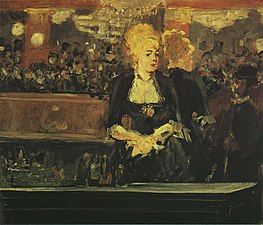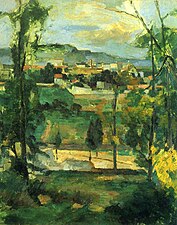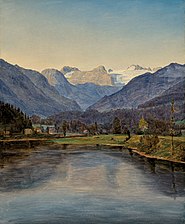Hermann Eissler
Hermann Eissler | |
|---|---|
| Born | 1860 Vienna |
| Died | 1953 Nice, France |
| Nationality | Austrian |
| Other names | Dr. Hermann Eissler |
| Occupation | art collector |
| Known for | art collection |
Hermann Jacob Eissler (20 July 1860 Vienna – 26 February 1953 Nice) was an Austrian entrepreneur and art collector persecuted and plundered by Nazis because of his Jewish origins.[1]
Early life[edit]
Eissler was born in Vienna in 1860. He was the son of the timber merchant, and stock broker, Jakob Eissler.
He studied at the Vienna Academic Gymnasium . He studied geology with Eduard Suess at the University of Vienna.[2] He married Barbara Havliscek, (died before 1917). In 1929, he married Hortense, née Kopp (1895-1983).[3]
He worked at "Josias Eissler & Söhne", which was located at Vienna I., Singerstraße 8; branch in Mistelbach, Lower Austria, Wienerstraße 15-17.[4]
Art collection[edit]
Eissler collected paintings, works on paper and sculptures, with his brother Gottfried (1861-1924). The Eisslers were among the best known and most important collectors in Vienna. Their art collections included Rodin, Goya, Galasso-Galassi[5] and Italian, French and Spanish artists as well as 19th century Austrian artists such as Ferdinand Georg Waldmüller and Rudolf von Alt.[6]
Nazi persecution[edit]
When the Nazis integrated Austria into the Third Reich with the Anschluss in 1938, Eissler was persecuted because he was Jewish. In October 1938, the artworks in his collection were divided within the family between Eissler's wife, who was considered 'Aryan', and Eissler's daughter; nevertheless, the collection was seized shortly thereafter on the basis of the law prohibiting the export of monuments (see § 4a BGBl. Nr. 80/1923).[6]
In the spring of 1939, he fled to Hungary. He then emigrated to France, via Switzerland and lived in Nice.[7]
Some of his collection was appropriated by state museums, some works secreted to France, and some sold.[8]
Postwar attempts to reclaim artworks[edit]
After World War II, his widow and daughter tried to recover works of art from Austrian state ownership.[2] Only some of the collection was restored to his heirs.[9][10] Others are still being searched for.[11] Works from his collection, are in the National Gallery of Art.[12] Restitutions include:
- View of Lake Altaussee and the Dachstein by Ferdinand George Waldmüller (1834) on loan by the German government to the Staatliche Kunsthalle Karlsruhe, restituted to the heirs of Hermann Eissler in 2020.[13][14]
- Wildbach Strubb [Der Wildbach Strubb bei Ischl] by Ferdinand George Waldmüller (1831) restituted to the heirs of Hermann Eissler in 2020[15][16]
- Flora, Hygieia, Hippokrates, and Galen, (four paintings) by Ferdinand George Waldmüller, restituted in 2012.[17][18]
Gallery[edit]
-
Le bar aux Folies-Bergère, Édouard Manet
-
Village derrière des arbres, Île-de-France, Paul Cézanne
-
Self-Portrait, Vincent van Gogh
-
View of Lake Altaussee and the Dachstein, Ferdinand Georg Waldmüller
References[edit]
- ^ "German Lost Art Foundation - News - German government restitutes Nazi-confiscated property". www.kulturgutverluste.de. German Lost Art Foundation. Archived from the original on 26 September 2020. Retrieved 2 May 2021.
Dr. Hermann Eissler was a Jewish businessman based in Vienna. He was persecuted by the National Socialists from March 1938 onwards, and in fall 1938, he transferred paintings from his collection to his wife, who was "Aryan" in National Socialist terminology. He fled Vienna for France in spring 1939.
- ^ a b "Eissler, Hermann | Lexikon der österreichischen Provenienzforschung". www.lexikon-provenienzforschung.org. Retrieved 30 November 2020.
- ^ "Eissler, Hermann | Lexikon der österreichischen Provenienzforschung". www.lexikon-provenienzforschung.org. Retrieved 2 May 2021.
- ^ "Lost Art Internet Database - Jüdische Sammler und Kunsthändler (Opfer nationalsozialistischer Verfolgung und Enteignung) - Eissler, Dr. Hermann". www.lostart.de. Retrieved 13 November 2021.
- ^ "Lost Art Internet Database - Jüdische Sammler und Kunsthändler (Opfer nationalsozialistischer Verfolgung und Enteignung) - Eissler, Dr. Hermann". www.lostart.de. Retrieved 13 November 2021.
Die Sammlung enthielt u.a. Werke von Rodin, Galasso-Galassi, Goya, Waldmüller und Rudolf von Alts.
- ^ a b "Eissler, Hermann | Kommentierte Online-Edition der fünf Reisetagebücher Hans Posses (1939 -1942)". editionhansposse.gnm.de. Retrieved 13 November 2021.
- ^ "DÖW - Erinnern - Fotos und Dokumente - 1934 - 1938 - "Krachendes Österreich" - Opfer des Terrors der NS-Bewegung in Österreich 1933 - 1938 - Hermann Eissler". www.doew.at. Retrieved 30 November 2020.
- ^ Lillie, Sophie (2003). Was einmal war : Handbuch der enteigneten Kunstsammlungen Wiens. Czernin. pp. 322–329. ISBN 3-7076-0049-1. OCLC 450860255.
- ^ "Lost Art Internet Database - Jüdische Sammler und Kunsthändler (Opfer nationalsozialistischer Verfolgung und Enteignung) - Eissler, Dr. Hermann". www.lostart.de. Retrieved 30 November 2020.
- ^ "FERDINAND GEORG WALDMÜLLER (VIENNA 1793-1865 HINTERBRÜHL), View of Lake Altaussee and the Dachstein". www.christies.com. Retrieved 30 November 2020.
- ^ "Lost Art Internet Database - search request". www.lostart.de. Archived from the original on 2 May 2021. Retrieved 2 May 2021. (Lost Art-ID 417778 Permalink http://www.lostart.de/EN/Verlust/417778 Artist / Create Galassi, Galasso d. Ä. Biographical data 1370-1438 Title Christus am Ölberg Dating 1460 Type of object Painting Generic terms Group of people biblical / Christian / sacred Measures Height: 159.00 cm Width: 239.00 cm Material / Technique Oil: canvas / painted Description Mü-Nr.: 7535; Linz-Nr.: 2438 Provenance Collection Dr. Eissler, Wien; Hortense Eissler; october 1940 purchased by Dr. Hans Posse for the so called Linz collection; whereabouts: Austria Circumstances of loss 1940)
- ^ "Provenance". www.nga.gov. Retrieved 30 November 2020.
- ^ "FERDINAND GEORG WALDMÜLLER (VIENNA 1793-1865 HINTERBRÜHL)". www.christies.com. Archived from the original on 1 May 2021. Retrieved 1 May 2021.
Dr. Hermann Eissler (1860-1953), Vienna, by 1930. Banned from export under the Nazi regime and held in the apartment of the above, 29 October 1938. Berta Morelli (1893 – 1975), Vienna, by December 1938, acquired as a gift from her father, Dr Hermann Eissler. Purchased by Maria Almas Dietrich, Munich, together with two other paintings by Waldmüller from the above and Hortense Eissler for Reich Chancellery in May 1939. Reich Chancellery, by whom acquired from the above as part of the collection for the planned Linz Museum (Linz no. 734). Recovered by the Monuments, Fine Arts and Archives Section for the Salt Mines, Alt Aussee (no. 6442), and transferred to the Central Collecting Point, Munich, 22 October 1945 (MCCP no. 11228). with Galerie Nathan, Zurich. Transferred into the custody of the Bavarian Ministerpräsident, December 1948, thereafter into the custody of the German federal government, June 1949. On loan from the above to the Staatliche Kunsthalle Karlsruhe, 1966 (inv. no. Lg 755). Restituted to the heirs of Dr Herman Eissler in 2020.
- ^ "Lost Art Internet Database - found-object report". www.lostart.de. Archived from the original on 2 May 2021. Retrieved 2 May 2021.
Provenance (…) Spätestens ab 1930–spätestens bis April 1939 Dr. Hermann Eissler (1860–1953), Wien Spätestens ab April 1939 Hortense Eissler (1895-1983), Wien, erworben als Geschenk. 1939 Galerie Almas, München. Ab 1939 Reichsvermögen ("Sonderauftrag Linz"). Ab Sommer 1943 Eingang in das Bergwerk Alt-Aussee. 22.10.1945 Eingang in den Central Collecting Point München. 1949–2020 Bundesvermögen. 2020 Restitution
- ^ "KVDB - Startseite - Wildbach Strubb [Der Wildbach Strubb bei Ischl]". kunstverwaltung.bund.de. Retrieved 1 May 2021.
Ein NS-verfolgungsbedingter Entzug an diesem Kulturgut und die Rechtsnachfolge des ursprünglichen Eigentümers wurden ermittelt. Die Restitution ist durch Unterzeichnung der Rückgabevereinbarung erfolgt.
- ^ "Lost Art Internet Database - found-object report". www.lostart.de. Retrieved 2 May 2021.
- ^ "Lost Art Internet Database - search request". www.lostart.de. Archived from the original on 2 May 2021. Retrieved 2 May 2021.
Provenance Collection Dr. Eissler, Vienna; June 1938 as a part of four panels purchased by the art dealer Maria Almas-Dietrich, Munich, for the so called Linz collection; whereabout: Austria
- ^ "Provenance Research | Belvedere Museum Vienna". www.belvedere.at. Retrieved 2 May 2021.
To the heirs of Dr. Hermann Eissler:Waldmüller, Ferdinand Georg: 4 Signboards for an apothecary: Hygieia, Hippokrates, Galen, Flora, Inv. No. 5621-5624




